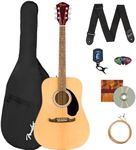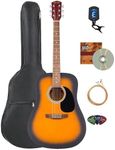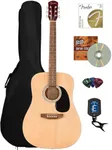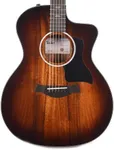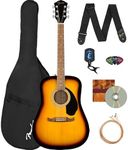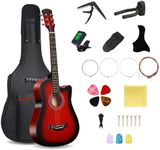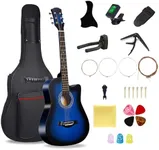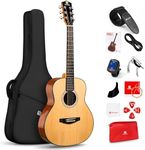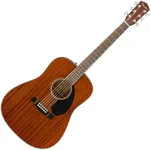Buying Guide for the Best Acoustic Guitars
Choosing the right acoustic guitar can be a rewarding experience, but it requires some understanding of the key specifications that differentiate one guitar from another. The right guitar for you will depend on your playing style, musical preferences, and physical comfort. Here are some important specs to consider when selecting an acoustic guitar.Body ShapeThe body shape of an acoustic guitar affects its sound and playability. Common shapes include dreadnought, concert, and jumbo. Dreadnought guitars are known for their powerful, balanced sound and are great for strumming and flat-picking. Concert guitars are smaller and more comfortable to hold, making them ideal for fingerpicking and lighter playing styles. Jumbo guitars have a larger body, producing a louder and bass-heavy sound, suitable for players who want a big, bold tone. Choose a body shape that feels comfortable to hold and suits your playing style.
TonewoodTonewood refers to the type of wood used in the construction of the guitar, which significantly influences its sound. Common tonewoods include spruce, mahogany, and rosewood. Spruce is a popular choice for the top (soundboard) due to its bright and clear tone. Mahogany offers a warmer, more mid-range focused sound, while rosewood provides a rich, complex tone with strong bass and treble. Consider the type of music you play and the sound you prefer when selecting the tonewood.
Neck ProfileThe neck profile describes the shape and thickness of the guitar's neck. Common profiles include C-shape, V-shape, and U-shape. A C-shape neck is rounded and comfortable for most players, making it a versatile choice. V-shape necks have a more pronounced ridge, which some players find easier for thumb-over playing styles. U-shape necks are thicker and can provide a more substantial feel, preferred by players with larger hands. Choose a neck profile that feels comfortable in your hand and suits your playing technique.
Scale LengthScale length is the distance between the nut and the saddle of the guitar. It affects the tension of the strings and the overall playability. Common scale lengths are 24.75 inches and 25.5 inches. A shorter scale length (24.75 inches) results in lower string tension, making the guitar easier to play and bend notes. A longer scale length (25.5 inches) provides more tension, which can result in a brighter tone and better note definition. Consider your playing style and hand strength when choosing a scale length.
Nut WidthNut width is the width of the guitar's neck at the nut, which affects the spacing of the strings. Common nut widths range from 1.65 inches to 1.75 inches. A narrower nut width (around 1.65 inches) is easier for players with smaller hands or those who prefer closer string spacing for faster playing. A wider nut width (around 1.75 inches) provides more space between the strings, which can be beneficial for fingerstyle playing and players with larger hands. Choose a nut width that feels comfortable for your hand size and playing style.
ElectronicsSome acoustic guitars come with built-in electronics, allowing you to amplify the sound for live performances or recording. These electronics typically include a pickup and a preamp with controls for volume and tone. If you plan to perform live or record your music, an acoustic-electric guitar with built-in electronics can be very convenient. If you primarily play at home or in small settings, a purely acoustic guitar without electronics may be sufficient. Consider your performance needs when deciding on electronics.



